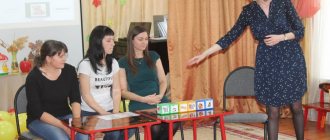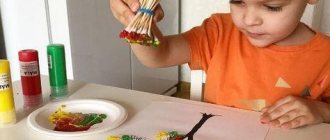MASTER CLASS FOR TEACHERS FLEXAGONS. Teacher Makhmutova R.A. MBDOU “Kindergarten 7 “Thumbelina”
Transcript
1 MASTER CLASS FOR TEACHERS FLEXAGONS Teacher Makhmutova R.A. MBDOU “Kindergarten 7 “Thumbelina”
2 Objectives of the work and expected results Objectives Increasing the professional skills of teachers of master class participants in the process of active pedagogical communication, mastering work experience; Constructing your own model of the educational process in front of the master class participants in the mode of demonstrated pedagogical technology; Training teachers in specific skills that form the basis of the transmitted teaching experience and ways to achieve the intended results. Expected results Practical mastery of skills by teachers as part of the transmitted experience; Activation of cognitive activity of master class participants; Increasing the level of their professional competence in the main aspects of the demonstrated activity; Increased motivation of master class participants to form their own style of creative pedagogical activity.
3 What is a flexagon? A little history At the end of 1939. Arthur Stone, a graduate student in England studying mathematics, trimmed sheets of American notebook paper to fit a familiar format. Wanting to have fun, Stone began to fold various shapes from cut strips of paper. One of the figures made turned out to be especially interesting Flexagon (from English to flex, which means “fold, bend”) Flexagon is a polygon folded from a strip of paper, curved in shape, which has an unusual property: when flexagons are bent, their outer surfaces are hidden inside, and Hidden surfaces suddenly come to light.
4 Features of flexagons Spatial modeling based on origami. This technology is very attractive, since the peculiarity of gaming materials for them is the unlimited combinatorial capabilities of an ordinary sheet of paper. If we consider that an ideal constructor should consist of one piece, with the help of which an infinite variety of shapes can be created, then origami is just such a constructor. Flexagons, as a means of mathematical modeling, have the following distinctive features: Cost-effective. To make flexagons you need paper, glue, scissors and shape standards. Availability. With minimal help from an adult, the child not only finds the hidden surfaces of a flexagon, but also models flexagons using a ready-made scan, while gaming and search tasks dominate, and the assimilation and consolidation of program skills and skills in elementary mathematics become motivated and active. Multifaceted developmental character. Flexagons promote the development of fine motor skills, spatial imagination, memory, attention, patience; with specially thought-out coloring, they activate the formation of ideas in all sections of mathematics for preschoolers.
5 Recommendations for introducing children to flexagons The first two lessons use multi-colored hexahexaflexagons. Children discover a new “toy”, study its properties on ready-made models and its structure on their developments. The third lesson is devoted to reproductive modeling of hexahexaflexagon using a ready-made scan. The fourth lesson is to organize children’s independent modeling of a trihexaflexagon according to a diagram using a ready-made scan. In the fifth lesson, tritetroflexagon is introduced, the properties of which are different from the properties of the two previous flexagons. It is independently produced by children using a ready-made design and studied in group work using logical-mathematical games such as “Odd Four” and in individual work with children.
6 Methodological recommendations for teachers of preschool educational institutions When starting a lesson on getting acquainted with flexagons, I advise you to simultaneously reinforce in children the distinction between colors and their shades, since multi-colored flexagons (sample) are included in the group. For younger preschoolers, flexagons can, when assembled correctly, form any object, corresponding to the background color (tomato, strawberry, etc.). You can assemble the silhouette of an object in one way, or get a plain side in two ways. Therefore, when a child acts with a flexagon, he involuntarily complicates his cognitive task, which stimulates the development of motor skills, thinking and receiving a positive emotional charge. Older preschoolers can be asked to collect hexahexaflexagons by color. For example, each side of a hexahexaflescagon can consist of six triangles of additional colors, differing by 1-3 tones from the main color. This exercise is recommended for developing fine motor skills and stimulating the intellectual activity of children.
7 How to use flexagons with preschoolers in mathematics work As a means of ordinal and quantitative counting. With the help of flexagons, you can introduce children to the composition of numbers from units; relationships “more less”, etc.; numbers, learn to compose and solve simple arithmetic problems. For this purpose, various coloring of the sides of the flexagon is used, taking into account the interests of children of a particular group. In the “Geometric Shapes” section, introduce children to the triangle, circle, square, and quadrilateral as classes of shapes. Flexagons will help you find similarities and differences between figures and classify them. Flexagons are good for children to learn the concept of “time”. You can use them to demonstrate a watch dial, conveniently show seasonal phenomena, days of the week, months.
8 Creating a hexahexaflexagon 1 Materials for work: A4 sheet of paper, pencil, ruler, scissors and paper glue. First you need to cut two strips 4.5 cm wide along an A4 sheet and glue them together with an overlap of 5 mm.
9 Creating a hexahexaflexagon cm On the left we cut off a right triangle with a leg 2.7 cm long.
10 Creating a hexahexaflexagon We fold equilateral triangles like an accordion (19 triangles). We number the first side as in the picture above (1,2,3). The last triangle remains empty. The second side is numbered 4,4,5,5,6,6. The first triangle remains empty.
11 Creating a hexahexaflexagon 4 Fold the strip like a snake, starting from the triangles. 1.2. The result is on the next slide in the first photo.
12 Creating a hexahexaflexagon As soon as the tape is all folded like a snake, it needs to be placed on the table so that the empty triangle is on the back side, and the front side is with numbers. Now we bend the long tail of our snake once down along the red hatching (see in the photo) and a second time down along the line of red hatching.
13 Creating a hexahexaflexagon The result is a hexagon and one extra triangle. But we need all the numbers on the hexagon to be twos, but we have one three. Therefore, we put the end of the tape on it, where the number “two” is. Please note that you have a hexagon with the numbers “2” on the front side and the numbers “1” on the back. The remaining triangle tail should be bent so that it coincides with the same empty triangle. They should be glued together.
14 Result of work 1
15 Game with trihexaflexagon “Twelve” Equipment: Trihexaflexagon for each child. The first plane of the flexagon numbers from 1 to 12; second months; third clock face. Goals and objectives: - Introduce the properties of the trihexaflexagon - Strengthen the skill of forward and backward counting within Expand the understanding of the seasons, seasons and seasonal phenomena and the names of the months - Give an idea of time intervals (minute, second) - Activate knowledge about the cyclicity of time processes; continue to introduce the dial and the functions of the hour hands. Game progress 1. Give the children a few minutes to examine and play with the flexagons. The first plane is working. Children count up to 12 forward and backward, then count from the given number. They turn the flexagon inside out, count from memory, and check the result. 2. Repeat the names of the months. Children find the flexagon surface that is most suitable for this. Each season has a field of a certain shade. Children repeat the names of the months several times, moving their fingers from one to the other, the pace speeds up. 3. The children are shown a stopwatch. They are introduced to the time period by the second. It is noted how long it will take to find the hidden side of the flexagon. Children practice telling the minutes using a flexagon surface with a clock face on it.
16 Conclusion Flexagon is a mathematical puzzle. A very exciting, funny toy with amazing properties.









